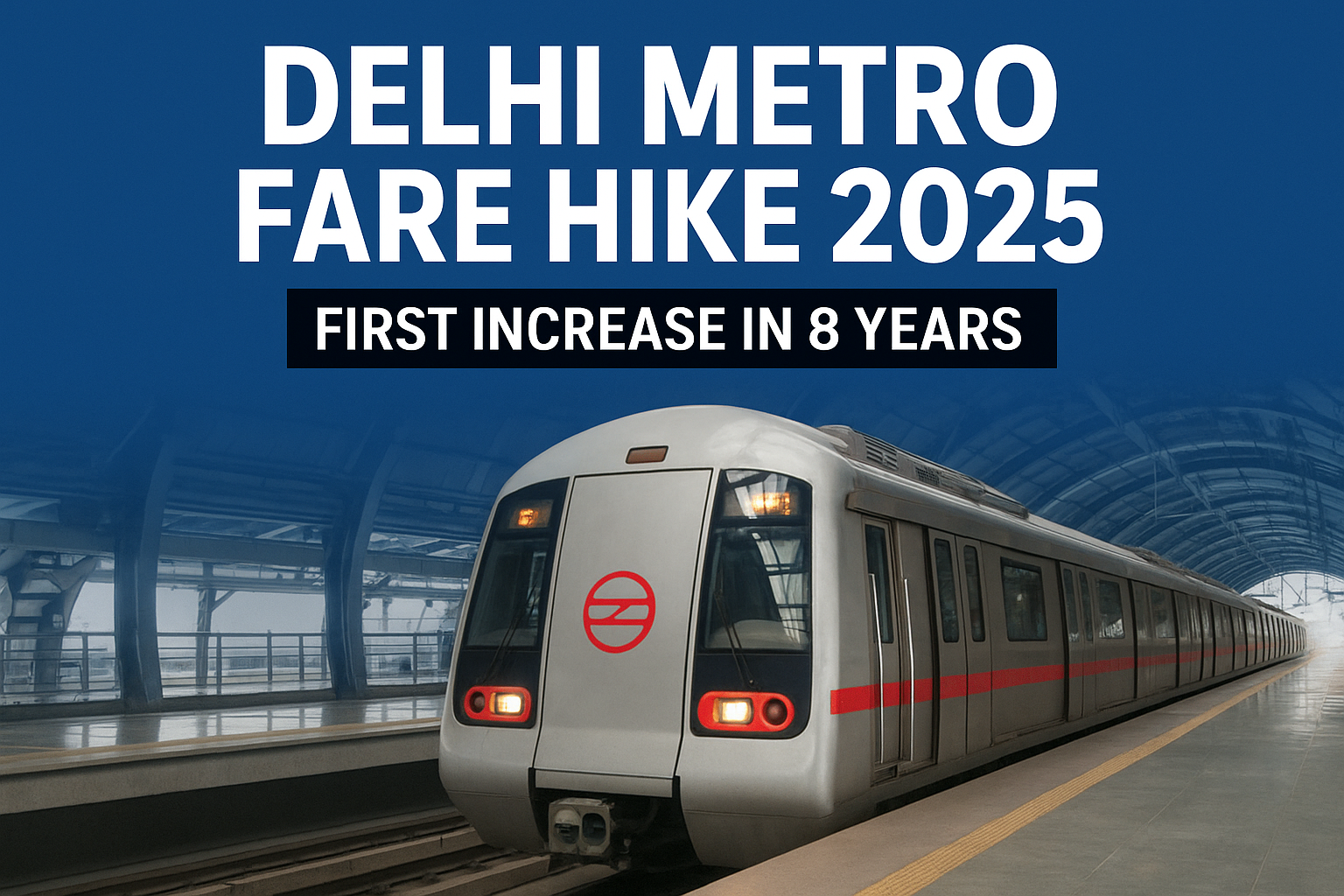The Delhi Metro Rail Corporation (DMRC) has officially revised fares starting August 19, 2025. For the first time since 2017, commuters will see a flat ₹10 increase across all distance slabs, while airport and premium express services remain unaffected.
Key Highlights of the 2025 Fare Revision
- First fare hike in 8 years (last in 2017).
- ₹10 increase across all slabs.
- No change for Airport Express Line and other premium services.
- DMRC cites rising electricity, staff salaries, and maintenance costs as reasons.
Updated Delhi Metro Fare Chart (2025)
| Distance Slab | Previous Fare | New Fare (2025) |
|---|---|---|
| 0–2 km | ₹10 | ₹20 |
| 2–5 km | ₹20 | ₹30 |
| 5–12 km | ₹30 | ₹40 |
| 12–21 km | ₹40 | ₹50 |
| 21–32 km | ₹50 | ₹60 |
| 32+ km | ₹60 | ₹70 |
Note: Airport Express Line fares remain unchanged.
Why the Hike Was Announced
DMRC has stated that operational expenses have increased sharply:
- Electricity costs form nearly 40% of operating expenses.
- Staff salaries and maintenance costs have risen significantly.
- No revision in fares since 2017 despite inflationary pressures.
“To maintain high service standards and ensure financial sustainability, fare rationalization was necessary,” a DMRC spokesperson said.
Public Reaction and Commuter Concerns
For lakhs of Delhi-NCR commuters, this hike means a noticeable rise in monthly travel budgets.
- Daily office-goers who travel 20–30 km one way will now spend ₹400–600 more per month.
- Students and lower-income groups have voiced concerns, especially as bus and auto fares have also risen in recent years.
- On social media, reactions have been mixed:
- “First the traffic jams, now higher Metro fares. Commuting in Delhi is getting tougher,” wrote one commuter on X (Twitter).
- Others acknowledged that Metro is still cheaper than taxis or ride-hailing apps for long distances.
A Look Back: Timeline of Delhi Metro Fare Hikes
- 2009: Base fare ₹6–₹22.
- 2011: Revised to ₹8–₹30.
- 2017: Increased to ₹10–₹60 (current slabs until 2025).
- 2025: Raised to ₹20–₹70.
This shows that while hikes have been infrequent, each revision has been steep and flat, sparking debates over affordability vs sustainability.
How Delhi Metro Compares With Other Indian Cities (2025)
| City Metro | Starting Fare | Maximum Fare | Notes |
|---|---|---|---|
| Delhi Metro | ₹20 | ₹70 | Largest network, 400+ km. |
| Bengaluru Namma Metro | ₹10 | ₹60 | Gradual hikes, slower expansion. |
| Mumbai Metro | ₹10 | ₹40 | Limited corridors, bus still dominates. |
| Hyderabad Metro | ₹10 | ₹60 | PPP model, similar slabs to Bengaluru. |
Despite the hike, Delhi Metro still offers more distance per rupee than most other Indian metro systems.
Policy and Governance Angle
The 2017 fare revision sparked tensions between the Delhi Government and DMRC, with the state pushing to keep fares low while DMRC stressed financial sustainability. This time, the increase was implemented with less visible conflict, suggesting better alignment between stakeholders — though debates on subsidies and affordability will likely resurface.
What Commuters Should Expect Next
- Smart Card Advantage: Passengers using smart cards continue to get up to 10% discount on fares.
- Peak vs Off-Peak Debate: DMRC has hinted at future fare innovations, possibly differentiated peak-hour pricing.
- Long-Term Outlook: Unless alternate funding (advertising, state subsidy, PPP models) increases, periodic fare revisions are inevitable.
FAQs
1. Why did Delhi Metro hike fares in 2025?
To offset rising operational costs such as electricity, staff salaries, and maintenance, which had gone up significantly since the last revision in 2017.
2. How much is the fare hike?
A flat ₹10 increase across all distance slabs. Airport Express fares remain unchanged.
3. When was the last Delhi Metro fare hike before 2025?
In 2017, when fares were revised to ₹10–₹60.
4. How does Delhi Metro’s pricing compare to other cities?
Delhi’s fares are higher in starting slabs but still provide better distance coverage per rupee compared to Bengaluru, Mumbai, and Hyderabad.
5. Will fares increase again soon?
There’s no official announcement, but given cost trends, DMRC may propose smaller, periodic hikes in the future instead of large gaps.

